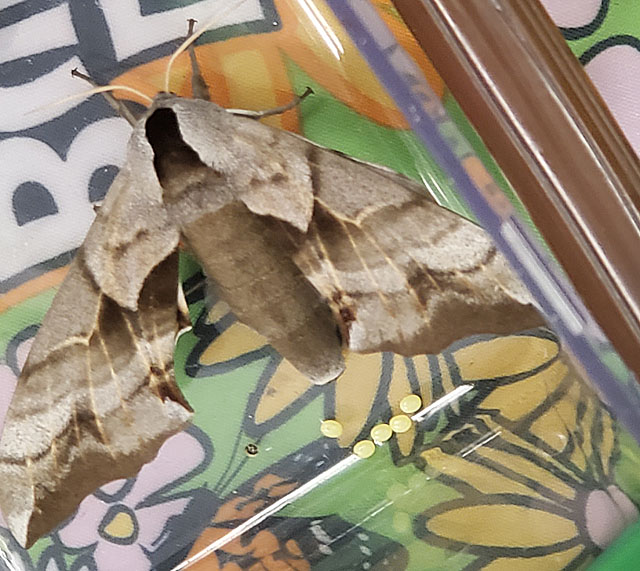Snohomish County
Sphingidae
Smerinthus ophthalmica female and eggs, Lynnwood, Snohomis County, Washington,
May 7, 2019, courtesy of Dallice Markfield.
|
|
Updated as per James P. Tuttle's The Hawk Moths of North America, July 24, 2010 Updated as per Butterflies and Moths of North America website, formerly USGS; July 24, 2010 Dedicated to Dallice Markfield, a fellow teacher and children in their care, May 8, 2019 |

Smerinthus ophthalmica female and eggs, Lynnwood, Snohomis County, Washington,
May 7, 2019, courtesy of Dallice Markfield.
This page is dedicated to Dallice Markfield, to a fellow daycare teacher and to the children. Dallice provides the Smerinthus ophthalmica
image at the top of the page. The moth was first spotted by a fellow teacher, and it caught the interest of the daycare children who asked how long the moth would
live.
I replied, helping with identification, "This moth is one of the Sphingidae, Smerinthus ophthalmica. The adult moths of this species have no mouth parts or feeding tubes and only live as adults for about 7-10 days until they have used up all their energy reserves. The female ophthalmica has a 5mm feeding tube which I think is non-functional. Some Sphingidae species have a much longer feeding tube and have a longer (about one month) adult moth life span, as they can imbibe nectar from flowers through the feeding tube, but not this species which does not feed as an adult moth.
I do not know if this species has a common name as it was long treated as a synonym of Smerinthus cerisyi whose common name is the One-eyed Sphinx or Cerisy's Sphinx. Dallice has suggested this one will go by the name of Western One-eyed Sphinx, at least at the daycare facility. There is another very similar species from Mexico, Texas, New Mexico, southern Arizona, and extreme southern California known as the Salicet Sphinx.
I am pretty sure that Dallice and the children are going to try to raise some of the caterpillars that hatch from the yellow eggs in the photo, and I wish them luck.
The Cascades seem to be a barrier to some of the more eastern species.
A "USGS" indicates the moth is reported in USGS and/or in Moths of Western North America, #2. Distribution of Sphingidae of Western North America, revised, an excellent little booklet available through Paul Opler.
A "WO" after the species name indicates that I have no confirmed reports of this species in Snohomish County, but I (William Oehlke) expect that this moth is or might be present.
Please help me develop this list with improved, documented accuracy by sending sightings (species, date, location), preferably with an image, via email to Bill Oehlke.
If you are a travellor, you can access similar pages for all Washington counties, all US states and Canadian provinces and all other countries in North, Central and South America
via the links at Sphingidae of the Americas.
You can access similar pages for Catocala (unerwing) moths at North American Catocala.
Sphinginae subfamily
Smerinthini Tribe:
Macroglossinae subfamilyDilophonotini tribe:
Macroglossini tribe:
|
Enjoy some of nature's wonderments, giant silk moth cocoons. These cocoons are for sale winter and fall. Beautiful Saturniidae moths will emerge the following spring and summer. Read Actias luna rearing article. Additional online help available.
Use your browser "Back" button to return to the previous page.
This page is brought to you by Bill Oehlke and the WLSS. Pages are on space rented from Bizland. If you would like to become a "Patron of the Sphingidae Site", contact Bill.
Please send sightings/images to Bill. I will do my best to respond to requests for identification help.
 Show appreciation for this site by clicking on flashing butterfly to the left. The link will take you to a page with links to many insect sites. |